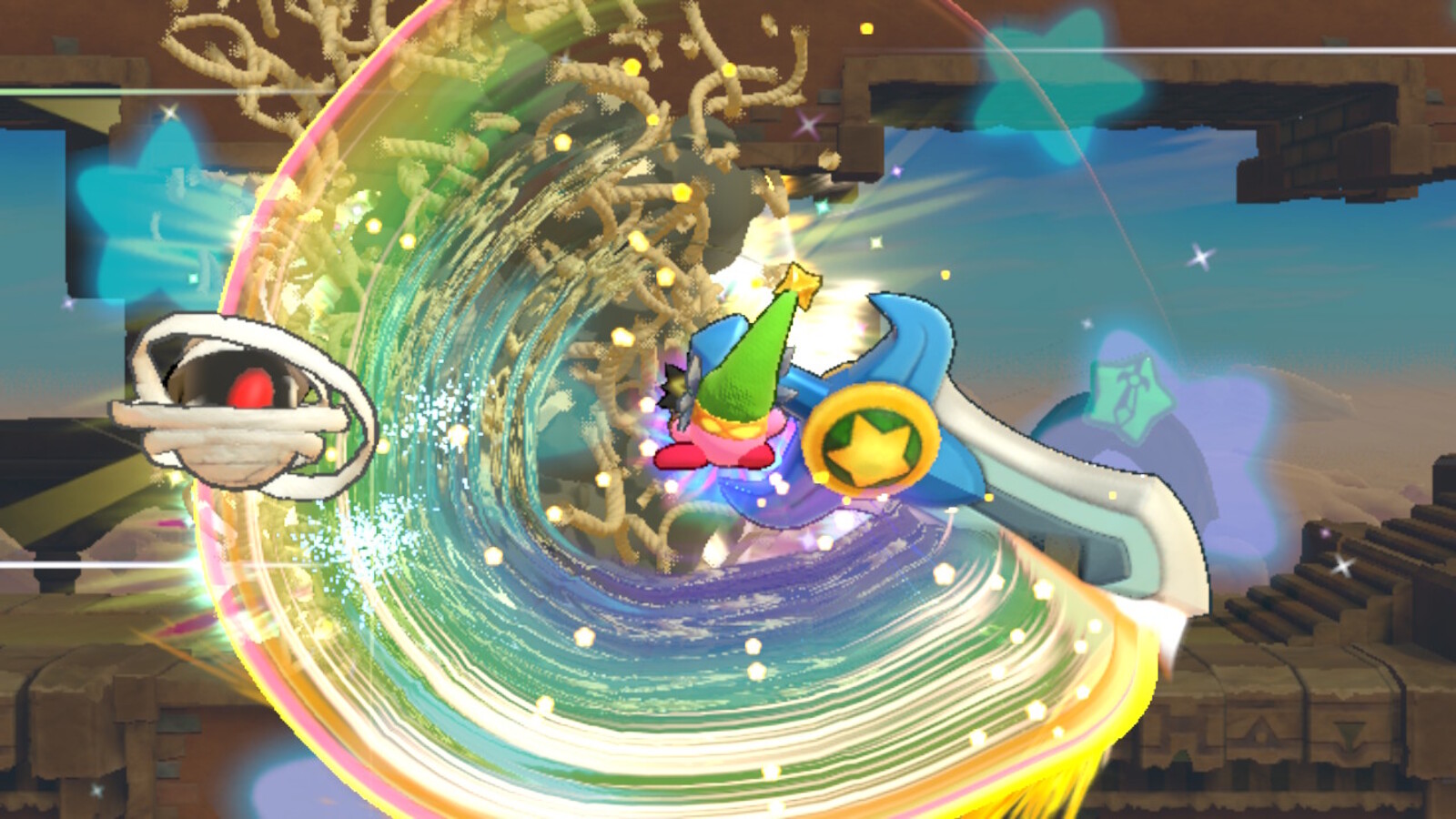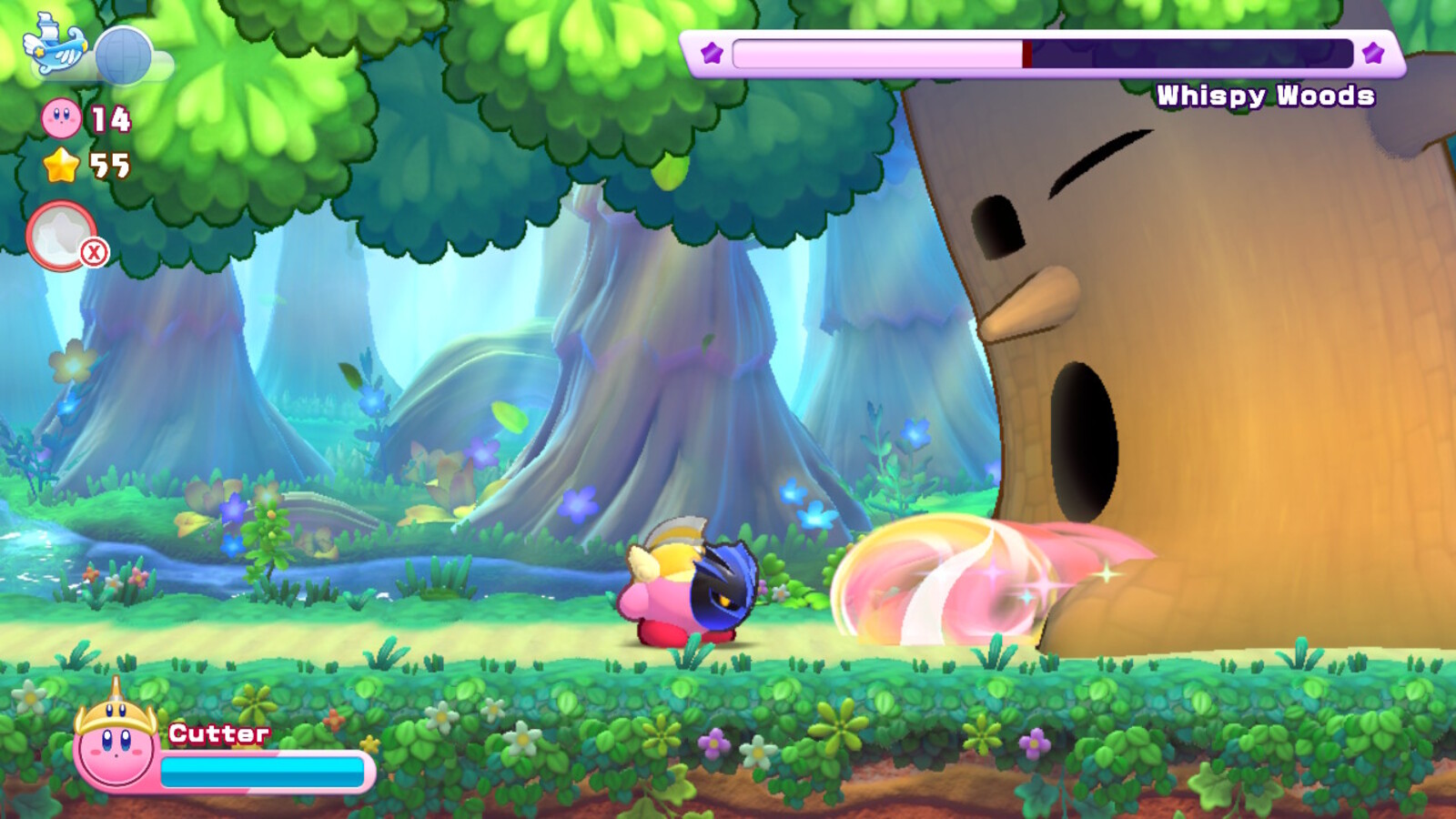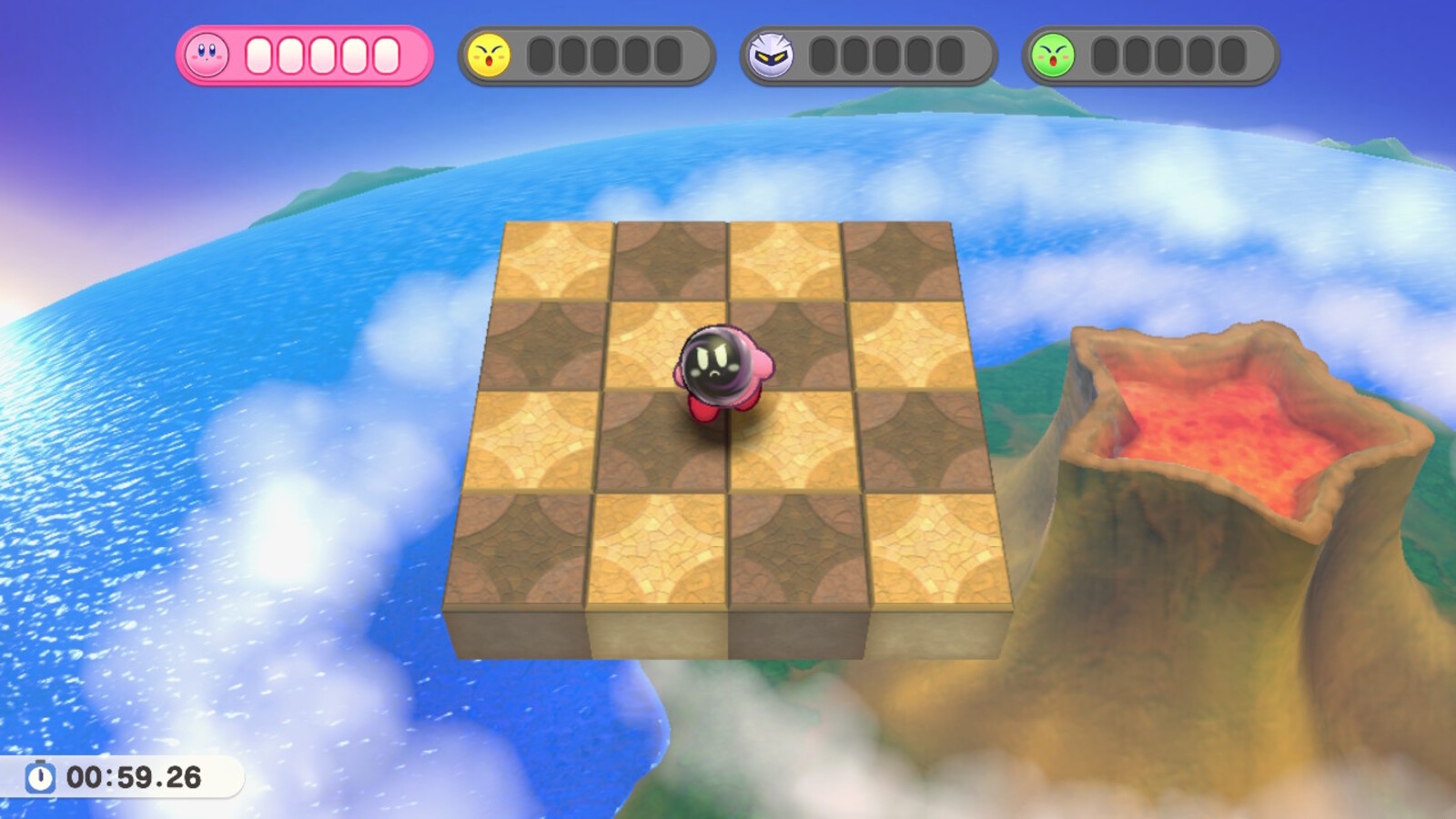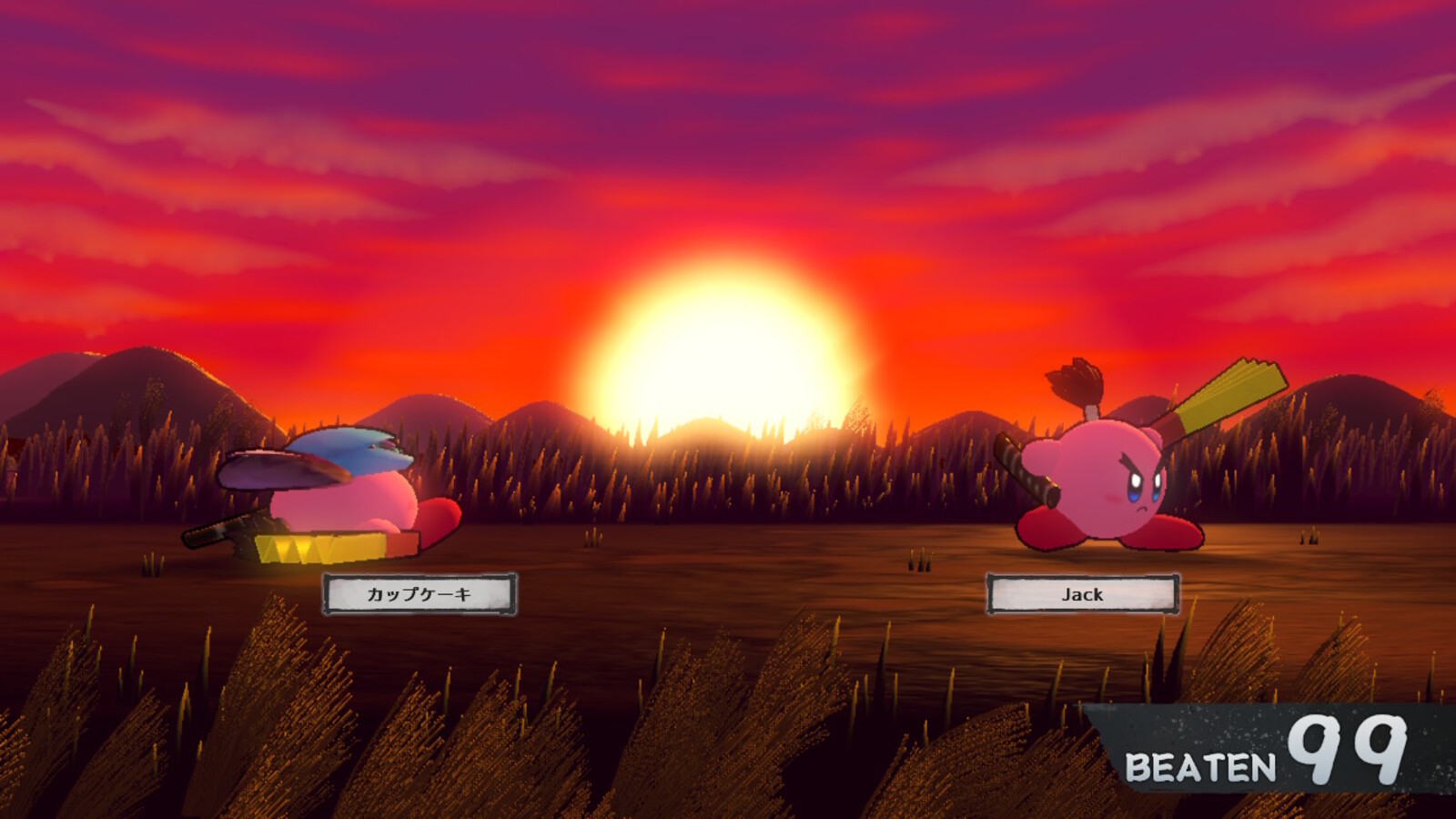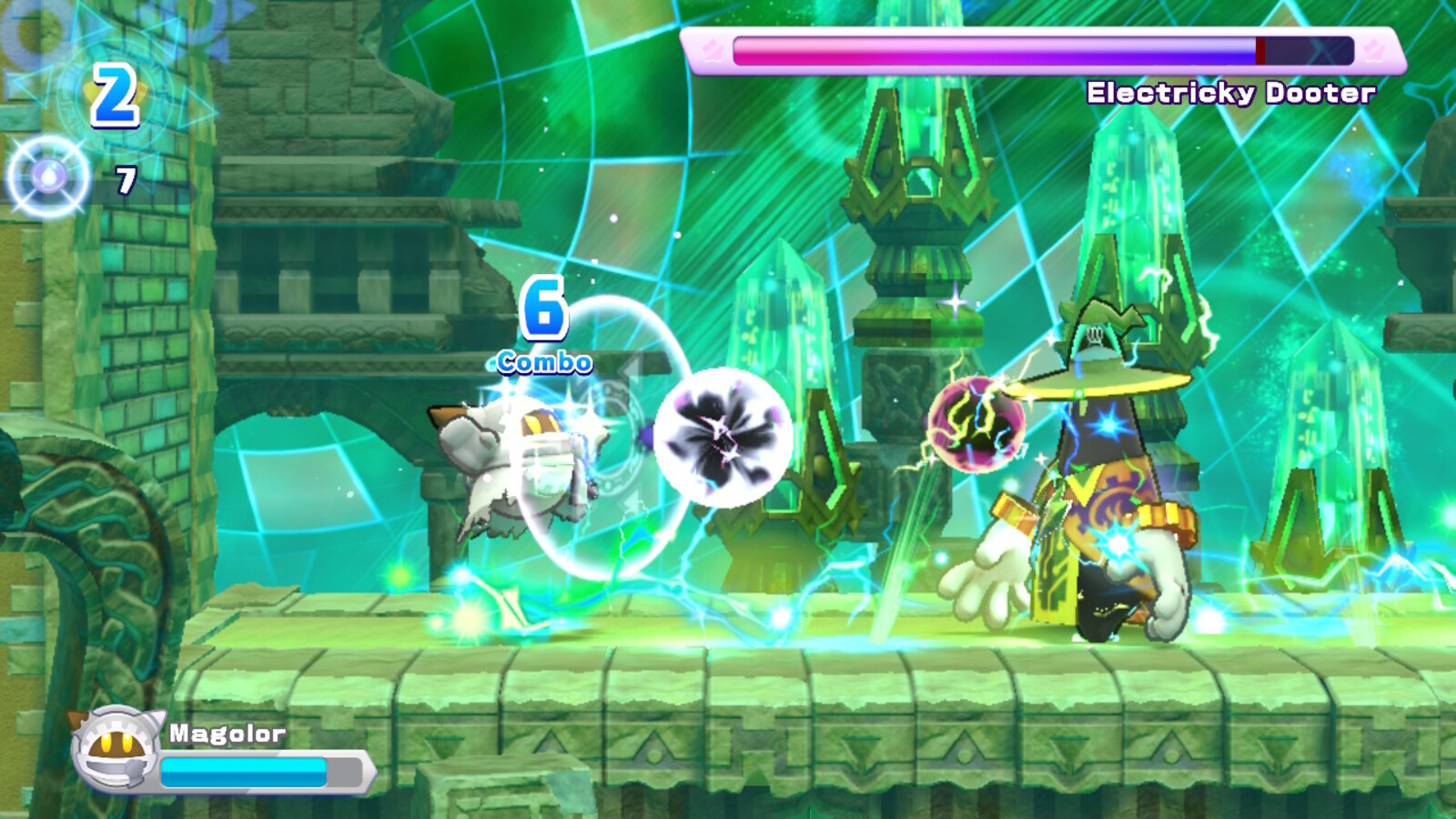
Kirby never struck me as a particularly sentimental guy. He makes friends easily and embarks on the next world-spanning conquest easier. In comparison, Return to Dream Land, practically drowns in sentiment, even before this latest Deluxe rerelease. It returns Kirby not only to Dream Land (it might be a stretch to say he ever truly left) but to a “typical” style of Kirby game. Return to Dream Land may in fact be the de facto Kirby game – it contains everything that makes Kirby games what they are and then some. It takes a sentimental look back on what makes Kirby tick, demonstrating the strength of this series as a whole.
Context matters here. In the years preceding Return to Dream Land, typical Kirby adventures became the exception rather than the rule. In a way then, Return To Dream Land re-centers Kirby on what Kirby does best, which is arguably being a two-dimensional platformer stuffed to the brim with uniquely “Kirby” mechanics.
Return to Dream Land grounds the series back on its fundamental ideas. While it most closely resembles Kirby’s second game, Kirby’s Adventure, in terms of structure, it borrows a little bit of everything that makes Kirby fun. Kirby floats and sucks up enemies like he’s been able to do from the beginning. He gains access to select enemy abilities upon consuming them as established from the second game onwards, and further fleshes out his arsenal with surprisingly intricate movesets in line with Kirby Super Star. These aspects when combined form, in my mind at least, the “definitive” Kirby experience.
Kirby games are fun because they are fun to play. I assure you that the prior sentence actually means something. The mechanics drive the fun of the game – sucking up enemies and using them against each other results in a system that keeps you experimenting. A typical Kirby level acts almost like a toy box. You always want to run ahead and eat up the next bad guy, because you might get a cool power or simply because it’s fun to do. Kirby games are games that anyone can enjoy due to this toybox nature.
Since Kirby games aim to be something that anyone can enjoy, it naturally follows that they are also games that anyone can complete. You don’t derive fun out of Kirby because it challenges you, at least not at first. Instead, they follow what I’d call a “perfect circle” theory of design. Anyone can draw a circle, but it’s much harder to draw a “perfect” circle. Similarly, anyone can finish a Kirby game, but it’s much harder to complete them 100%.
Return to Dream Land does not stray from this formula. The primary way it poses a challenge is with its “energy sphere” collectibles. Basically, each level contains a bunch of collectibles that are hidden both in plain sight and behind various secret challenges. On one level, I think these collectibles work great. They often force you to think outside the box for how Kirby’s powers can be used, while also being totally ignorable if you just want to mess around. If you do set your mind toward collecting them all, however, they come with a likely unintended consequence.
These energy spheres set your expectations for each level in a strange way. If you take each level at face value, they all offer new ideas and have their own identity. Yet if you’re paying attention to the collectibles, it also becomes apparent that in some ways they are all extremely similar. As you collect these spheres, the level’s structure and pacing become obvious. Their distribution follows certain patterns where once you’ve played through a world or two, you generally know what to expect for the entire rest of the game. It makes the game feel more predictable and same-y than it really should.
It may be a stretch to say that it’s some fatal flaw that the levels all generally follow the same pacing and structure. I’m not confident it would have even bothered me if the game didn’t tell me ahead of time how many spheres were in each level and keep their presence on the screen at virtually all times. I do notice it, though, and it’s hard not to find the game uncomfortably complacent in this regard. In a game that relies on recapturing a formula, this is one area where it may in fact be too formulaic.
Formula serves as Return to Dream Land’s greatest strength and weakness. If you devote your life to studying Kirbology, nothing Return to Dream Land sucks up and spits out will surprise you. You’ll recognize many of the enemies, powers, and even bonus content from prior games. That’s not necessarily a bad thing.
Return to Dream Land understands the core fun of Kirby and executes it extremely well. The game looks great, feels great, and has more than enough content to keep you busy. Even if you complete the normal mode, the game pushes you further with an extra hard difficulty as well as boss challenges. It even offers a multiplayer mode, which complements the generally laid-back platforming design of Kirby well. The mayhem caused by multiple players gets curbed to a manageable degree in a game more than willing to forgive some mistakes.
If Kirby’s Return to Dream Land Deluxe only offered the original game, it would stand as a strong example of the power of sentiment. The people who made it clearly love and appreciate the strengths Kirby brings to games. Return to Dream Land renews those strengths and pushes them forward for a new generation. That’s partly what makes this Deluxe edition interesting – it returns to a return, further enhancing the strengths of these sentiments.
In part, this Deluxe version functions as a simple remaster of a twelve year old game, but saying “simple remaster” might understate things. Return to Dream Land Deluxe refreshes the game on both an audio and visual level. While most of the soundtrack from the original carries over intact, it has been remastered with higher sound quality and minor alterations to the compositions. Graphically, the art style has been touched up throughout, with the biggest change being the addition of thick outlines around the characters. While this change likely exists to accommodate the multiplayer mode more than anything else, it adds a striking quality to the visuals that the prior version of the game lacked.
As the “Deluxe” implies, this new release also adds content rather than just messing with what already exists. Here, the primary additions consist of a dedicated mini game collection mode, “Merry Magoland,” and a “Magolor Epilogue” mode with a new playable character and story. Plenty of Magolor for all of the Magoheads out there.
Merry Magoland immediately enthralled me. Mini games are a time-honored tradition in Kirby games, and Merry Magoland pays special tribute to this heritage. It offers a selection of faithfully recreated mini games from across the series, as well as a few new ones. Kirby mini games tend to strike an interesting balance between simple ideas and surprising depth, especially in the context of multiplayer, and Merry Magoland brings some of the best back from the grave.
Kirby 64 originated my favorite Kirby mini games, so I was especially happy to see the Checkerboard Chase game from 64 made the cut. Basically, you create lines of dropping blocks and try to catch other players in your line of fire to drop them into the abyss. It asks players to balance attacking others and avoiding attacks, while incentivizing them to get up close to give them less time to react. It’s a perfect game of risk and reward. This new version further expands upon the game by offering a high speed mode, which further adds to the hectic nature.
I got way into playing these games in part because they are fun and in part because they come with great rewards for playing. As you play, you can complete specific missions, which gives you stamps that unlock masks for Kirby and friends to wear both in Magoland and the main game. These masks thoroughly dig through Kirby’s past adventures and give visual representation to just about every notable character in the franchise. They celebrate Kirby’s legacy in a cool and fun way.
It seems exceedingly fitting for a game all about recapturing Kirby’s core appeal to go back and give special attention to Kirby’s mini game legacy as well. Not every game gets substantive additions, but they are all generally well made. When the mini games do take advantage of the new technology, it integrates them in interesting ways. The idea of turning the Samurai Kirby mini game into a pseudo-Battle Royale is a particularly inspired touch.
Although I spent an excessive amount of time in Merry Magoland, I suspect that the new Magolor epilogue will be the main draw for returning players. I don’t know who clamored for a deeper dive into what is in all likelihood the worst day of Magolor’s life, but I’m glad they spared a thought for him regardless. Magolor’s epilogue mode may be my favorite aspect of the game.
In contrast to the main game, Magolor’s levels are much shorter and more focused affairs. This focus suits Magolor well, who unlike Kirby has a very defined moveset. Your relationship with enemies differs greatly from the usual routine – they are now pure obstacles rather than toys to play around with.
Although Magolor’s playstyle revolves around set limitations, in some ways that is more freeing than controlling Kirby. Kirby’s abilities are transitory, always changing depending on what’s in front of you. With Magolor, you steadily build up an arsenal of attacks and movement abilities. By the time you reach the end, you feel extremely powerful. At least until the end boss humbles you a bit.
Return to Dream Land thrives off of sentiment, yet I’m glad that this Deluxe edition doesn’t dwell completely on it. With the Magolor Epilogue in particular, it repurposes the old to create something that treads some new territory. This mode contrasts with the Kirby you know in interesting ways.
Kirby's Return to Dream Land Deluxe
Great
When you return to a return, you risk drowning in sentiment to the detriment of the experience. Instead, Return to Dream Land Deluxe skillfully channels its sentiments to refresh Kirby’s legacy and add something new on top of it. It is perhaps the most Kirby game to ever Kirby, and there's nothing wrong with that.
Pros
- Captures Kirby at his most Kirby
- Nice audio and visual refresh
- Tons of content
- Deluxe additions are strong
Cons
- Falls into too comfortable of a rhythm
- Not a fan of that Magolor Book mini game!

